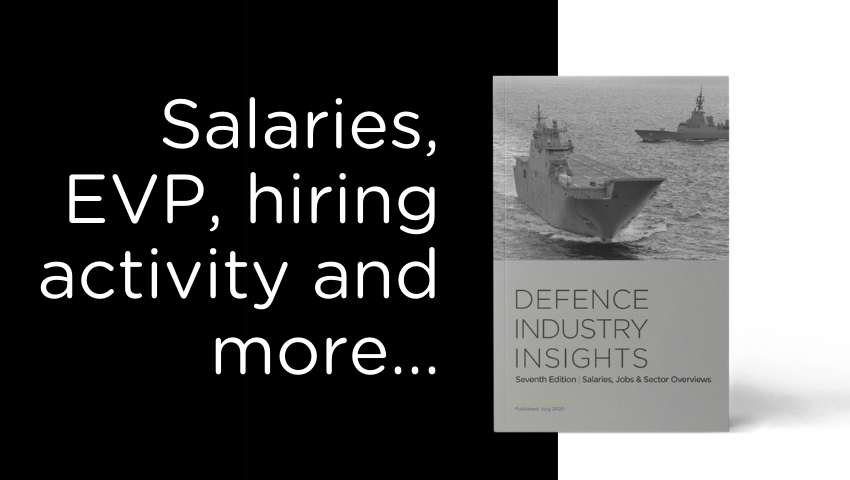Promoted by Kinexus
Kinexus' Industry Insights (7th Edition) is now available and packed full of intel to help defence companies make smart, well informed workforce decisions.
Kinexus has been formally surveying the defence industry workforce since 2005, and in that time we have seen fundamental shifts in the composition and expectations of the defence industry workforce.
The Defence White Paper of 2016 and the associated commitment to spend $198B on defence capability has been the latest catalyst for significant change, and this change brings great challenges, risks and opportunities to those involved in developing the industry workforce capability.
So, what are some of the workforce trends we have seen in the last year?
1) Salary increases softening
After steep rises of almost 5% in 2017/18 the rate of salary increase has fallen off significantly. Over the past 12 months defence industry salaries have increased by just 0.6% nationally. Over this same period, national Average Weekly Earnings increased by 3.2%. There are certainly some skills and locations that have still seen strong rises, but the majority have plateaued, and some have even decreased. (You will be pleased to know that we have colour coded the salary tables to show the movement from last year).
There are two main reasons for these results. Firstly, many defence employers have already reached the limits of what they have budgeted to pay in remuneration. Secondly, employers are constrained in their ability to offer higher salaries to attract new staff by the need to have consistency with the remuneration in place for existing staff.
2) Employer Value Proposition (EVP) is changing
Just a few years ago it would be uncommon for an engineer in industry to receive much beyond salary and superannuation when it came to entitlements and benefits. However, with an ever increasing focus on staff attraction and retention, employers are understanding the importance of offering workers more, and our surveys have shown that in the last 12 months the percentage of workers who receive additional benefits has risen from 58% to 68%. Our data also shows that individuals who receive some form of additional benefit are significantly less likely to look for work in the near future – a statistic that may prove pivotal as defence industry employers work hard to define and develop their EVP and communicate that to the market of potential future workers.
3) Employment mobility is decreasing
Despite some industry organisations experiencing retention problems, our data is showing a strong downward trend in employment mobility. As part of our annual workforce survey we ask, “Are you considering a change of employment in the near future?” Across the last three years, the percentage of respondents who told us they were looking for work in the next 12 months has decreased from 51% in 2018 to 39% in 2020.
The significant uplift in employment mobility that followed the 2016 White Paper and resulting defence industry stimulus has now slowed, and our opinion is that people who have moved jobs in the last one to two years are settled in their new home for the time being.
This situation is reinforcing the need to attract and integrate workers from outside of the defence sector. This is a great opportunity, but also bears some risk if not approached with care. Think not just of the importance of technical and procedural alignment, but of cultural alignment too.
4) Strong hiring activity
Hiring across acquisition and sustainment activities will continue at high levels in 2020/21, with naval and land projects creating strong demand for above and below the line workers. Certain skill sets have become increasingly hard to hire in some locations which is leading employers to establish workforces in locations where talent is more available.
The COVID-19 pandemic has slowed hiring in some areas, but is simply deferring demand rather that removing it, which will further complicate workforce development matters in the future.
5) Demographics
The Australian workforce continues to age, and our data suggests that this is also the case in defence industry. Whilst we would expect an influx of younger people into the industry in the next few years, we must not miss the chance to capture as much knowledge as possible from our more experienced workers before they leave the workforce.
So, what does this mean for the future? In July the Federal Government reiterated its commitment to defence spending and announced that it will spend $270B on defence over the next decade. Furthermore, there seems to be more energy and purpose in efforts to translate this investment into Australian industry capability. The intense debate on this important matter is moot unless we are able to make the most effective use of the existing workforce, whilst growing the workforce as efficiently as possible with people from the education sector and adjacent industries.
This challenge is significant, but not insurmountable. We would love to share our latest insights with anyone involved in creating workforce capability. We’re here with the intel and suporting services to help you make well informed, sound strategic decisions that lead to success, both now and into the future.
Download your free copy of the Defence Industry Insights – Seventh Edition here.
By Robert Kremer
Director & Defence Sector Lead
 Login
Login






